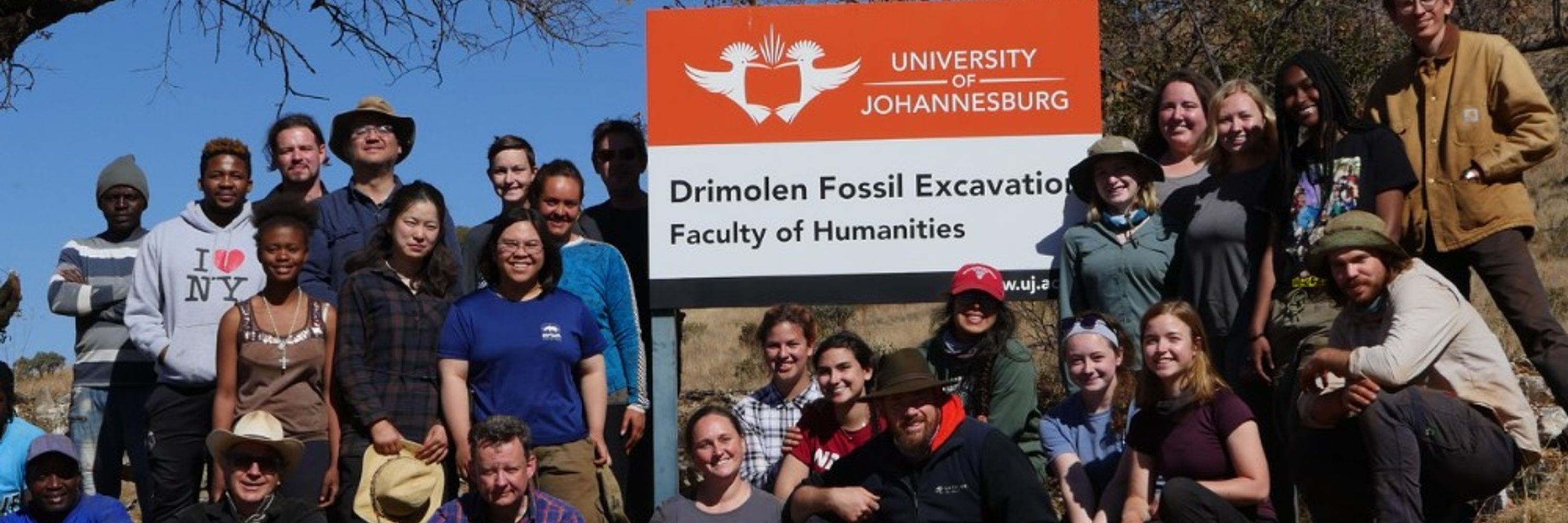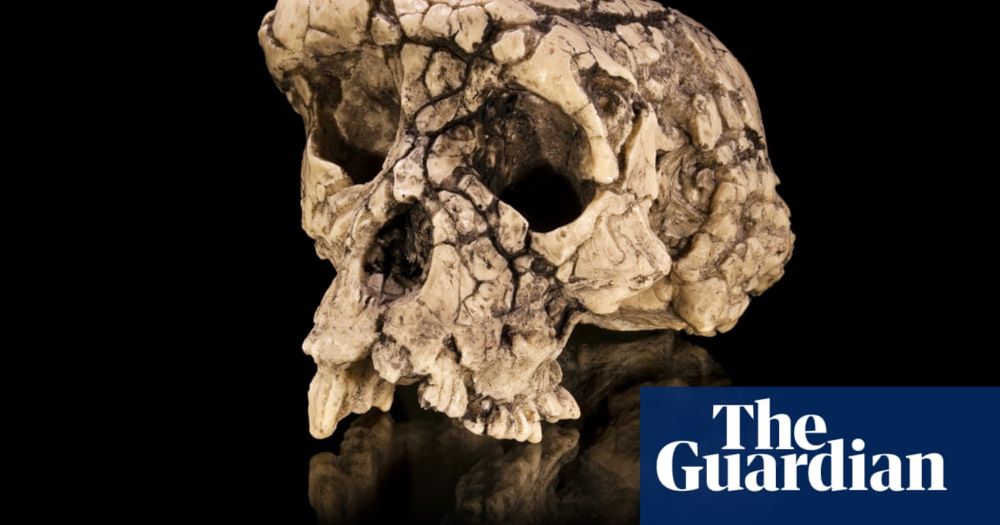
Andy I.R. Herries at La Trobe Archaeoogy
@ozarchaeomaglab.bsky.social
Palaeoanthropology & Geochronology Professor at La Trobe University Archaeology. Director of the Drimolen Palaeoanthropology Field School, Amanzi Springs & The Australian Archaeomagnetism Laboratory he/him
Long form news article in @science.org covering our latest collaborations between the Drimolen and Kromdraai teams as part of a new 4 year @Australian Research Council Discovery Grant
The world’s greatest concentration of ancestral human remains, in South Africa, poses a 2-million-year-old riddle of coexistence. scim.ag/46xvUwV

Three ancient human relatives once shared the same valley. Did they meet—and compete?
The world’s greatest concentration of ancestral human remains, in South Africa, poses a 2-million-year-old riddle of coexistence
scim.ag
July 27, 2025 at 9:03 PM
Long form news article in @science.org covering our latest collaborations between the Drimolen and Kromdraai teams as part of a new 4 year @Australian Research Council Discovery Grant
Reposted by Andy I.R. Herries at La Trobe Archaeoogy
The world’s greatest concentration of ancestral human remains, in South Africa, poses a 2-million-year-old riddle of coexistence. scim.ag/46xvUwV

Three ancient human relatives once shared the same valley. Did they meet—and compete?
The world’s greatest concentration of ancestral human remains, in South Africa, poses a 2-million-year-old riddle of coexistence
scim.ag
July 25, 2025 at 12:35 PM
The world’s greatest concentration of ancestral human remains, in South Africa, poses a 2-million-year-old riddle of coexistence. scim.ag/46xvUwV
Reposted by Andy I.R. Herries at La Trobe Archaeoogy
Uniform, circular, and shallow enamel pitting in hominins: Prevalence, morphological associations, and potential taxonomic significance 🏺🧪
www.sciencedirect.com/science/arti...
Remarkable consistency across species, time and geography suggests these enamel pits may be something quite interesting.
www.sciencedirect.com/science/arti...
Remarkable consistency across species, time and geography suggests these enamel pits may be something quite interesting.

June 27, 2025 at 4:33 PM
Uniform, circular, and shallow enamel pitting in hominins: Prevalence, morphological associations, and potential taxonomic significance 🏺🧪
www.sciencedirect.com/science/arti...
Remarkable consistency across species, time and geography suggests these enamel pits may be something quite interesting.
www.sciencedirect.com/science/arti...
Remarkable consistency across species, time and geography suggests these enamel pits may be something quite interesting.
Reposted by Andy I.R. Herries at La Trobe Archaeoogy
2-million-year-old pitted teeth from our ancient relatives reveal secrets about human evolution theconversation.com/2-million-ye...

2-million-year-old pitted teeth from our ancient relatives reveal secrets about human evolution
Curiously uniform dimples on the teeth of ancient hominins may give scientists a new way to trace their origins and relationships.
theconversation.com
June 9, 2025 at 3:38 PM
2-million-year-old pitted teeth from our ancient relatives reveal secrets about human evolution theconversation.com/2-million-ye...
Reposted by Andy I.R. Herries at La Trobe Archaeoogy
Uniform, circular, and shallow enamel pitting in hominins: Prevalence,
morphological associations, and potential taxonomic signals www.sciencedirect.com/science/arti...
morphological associations, and potential taxonomic signals www.sciencedirect.com/science/arti...

Uniform, circular, and shallow enamel pitting in hominins: Prevalence, morphological associations, and potential taxonomic significance
This study explores a particular form of enamel pitting originally identified in Paranthropus robustus. We call this uniform, circular, and shallow (U…
www.sciencedirect.com
June 7, 2025 at 6:41 AM
Uniform, circular, and shallow enamel pitting in hominins: Prevalence,
morphological associations, and potential taxonomic signals www.sciencedirect.com/science/arti...
morphological associations, and potential taxonomic signals www.sciencedirect.com/science/arti...
Worth a read for any up and coming Palaeoanthropologists about how not to behave. Let's leave this culture behind in our discipline.
www.theguardian.com/science/2025...
www.theguardian.com/science/2025...

The curse of Toumaï: an ancient skull, a disputed femur and a bitter feud over humanity’s origins
The long read: When fossilised remains were discovered in the Djurab desert in 2001, they were hailed as radically rewriting the history of our species. But not everyone was convinced – and the bitter...
www.theguardian.com
May 27, 2025 at 2:53 PM
Worth a read for any up and coming Palaeoanthropologists about how not to behave. Let's leave this culture behind in our discipline.
www.theguardian.com/science/2025...
www.theguardian.com/science/2025...
Reposted by Andy I.R. Herries at La Trobe Archaeoogy
💥Job Alert!!💥
We’re seeking to appoint a permanent Assistant Professor of Archaeological Science (materials), following the retirement of Prof. Julian Henderson.
Deadline May 5th 2025.
#Archaeology #archeology #archaeologicalScience 🧪
Full details here: jobs.nottingham.ac.uk/vacancy.aspx...
We’re seeking to appoint a permanent Assistant Professor of Archaeological Science (materials), following the retirement of Prof. Julian Henderson.
Deadline May 5th 2025.
#Archaeology #archeology #archaeologicalScience 🧪
Full details here: jobs.nottingham.ac.uk/vacancy.aspx...

Job Vacancy at the University of Nottingham: Assistant Professor in Archaeological Science (Materials)
The Department of Classics and Archaeology seeks to appoint an Assistant Professor in Archaeological Science (Materials) from 1 September 2025. Following £1.6 million investment from UKRI in our Archa...
jobs.nottingham.ac.uk
April 7, 2025 at 2:36 PM
💥Job Alert!!💥
We’re seeking to appoint a permanent Assistant Professor of Archaeological Science (materials), following the retirement of Prof. Julian Henderson.
Deadline May 5th 2025.
#Archaeology #archeology #archaeologicalScience 🧪
Full details here: jobs.nottingham.ac.uk/vacancy.aspx...
We’re seeking to appoint a permanent Assistant Professor of Archaeological Science (materials), following the retirement of Prof. Julian Henderson.
Deadline May 5th 2025.
#Archaeology #archeology #archaeologicalScience 🧪
Full details here: jobs.nottingham.ac.uk/vacancy.aspx...
Reposted by Andy I.R. Herries at La Trobe Archaeoogy
🏺 There is actually a perfume range called "Neanderthal" and it's gorgeous - I did a book giveaway with them!
(also I would totally be up for a real Viking scent)
(also I would totally be up for a real Viking scent)

April 1, 2025 at 7:48 AM
🏺 There is actually a perfume range called "Neanderthal" and it's gorgeous - I did a book giveaway with them!
(also I would totally be up for a real Viking scent)
(also I would totally be up for a real Viking scent)
Reposted by Andy I.R. Herries at La Trobe Archaeoogy
Guardian Australia @australia.theguardian.com reporting on the proposed changes to the ARC grants system.
There’s concern that getting rid of standalone fellowships will have lots of unintended consequences, especially for Early-Career Researchers.
By @donnadlu.bsky.social
There’s concern that getting rid of standalone fellowships will have lots of unintended consequences, especially for Early-Career Researchers.
By @donnadlu.bsky.social

Changes to ARC grants will make it harder for Australia to combat Trump chaos, researchers warn
Plan to cut most standalone positions in favour of shorter fellowships will hurt international recruitment, critics say
www.theguardian.com
April 1, 2025 at 3:08 AM
Guardian Australia @australia.theguardian.com reporting on the proposed changes to the ARC grants system.
There’s concern that getting rid of standalone fellowships will have lots of unintended consequences, especially for Early-Career Researchers.
By @donnadlu.bsky.social
There’s concern that getting rid of standalone fellowships will have lots of unintended consequences, especially for Early-Career Researchers.
By @donnadlu.bsky.social
Reposted by Andy I.R. Herries at La Trobe Archaeoogy
We are happy to share our pre-print on dating bone using a novel non-destructive protocol we developed. The paper is on the Biorxiv here (Luftensteiner et al. 2025):
www.biorxiv.org/content/10.1...
www.biorxiv.org/content/10.1...

Non-destructive radiocarbon dating of bone
Since the 1950s, radiocarbon measurements have anchored archaeological chronologies dating back to 50,000 years, with bone collagen being a commonly dated material. Despite advances in collagen extrac...
www.biorxiv.org
March 29, 2025 at 3:05 PM
We are happy to share our pre-print on dating bone using a novel non-destructive protocol we developed. The paper is on the Biorxiv here (Luftensteiner et al. 2025):
www.biorxiv.org/content/10.1...
www.biorxiv.org/content/10.1...
Reposted by Andy I.R. Herries at La Trobe Archaeoogy
I received a heartbreaking email today: A paper in a special issue I’m editing is being retracted because one of its authors is afraid of losing their job and their legal status in the U.S. if they publish a scientific study on evolution. Yes, on evolution, nature's engine of diversity.
March 29, 2025 at 11:52 PM
I received a heartbreaking email today: A paper in a special issue I’m editing is being retracted because one of its authors is afraid of losing their job and their legal status in the U.S. if they publish a scientific study on evolution. Yes, on evolution, nature's engine of diversity.
Latest paper out from the Drimolen team about the ~2 million year old DNH 43 Paranthropus pelvis from Drimolen Cave in South Africa. @ltuarchaeology.bsky.social
Analysis of an understudied 2-million-year-old fossil pelvis from the site of Drimolen, South Africa provides additional insights into the anatomy of early human relatives. doi.org/10.17159/saj... @caleyorr.bsky.social @ozarchaeomaglab.bsky.social

March 29, 2025 at 11:21 AM
Latest paper out from the Drimolen team about the ~2 million year old DNH 43 Paranthropus pelvis from Drimolen Cave in South Africa. @ltuarchaeology.bsky.social
Reposted by Andy I.R. Herries at La Trobe Archaeoogy
Analysis of an understudied 2-million-year-old fossil pelvis from the site of Drimolen, South Africa provides additional insights into the anatomy of early human relatives. doi.org/10.17159/saj... @caleyorr.bsky.social @ozarchaeomaglab.bsky.social

March 27, 2025 at 2:01 PM
Analysis of an understudied 2-million-year-old fossil pelvis from the site of Drimolen, South Africa provides additional insights into the anatomy of early human relatives. doi.org/10.17159/saj... @caleyorr.bsky.social @ozarchaeomaglab.bsky.social
Reposted by Andy I.R. Herries at La Trobe Archaeoogy
New paper from my lab & Drimolen team (@ozarchaeomaglab.bsky.social) on the DNH 43 hominin pelvis. I first saw it in 2019. Given the importance of the pelvis in the evolution of human locomotion and birth, I was surprised only a basic description had been published. 1/ #paleoanthropology 🏺🧪
Analysis of an understudied 2-million-year-old fossil pelvis from the site of Drimolen, South Africa provides additional insights into the anatomy of early human relatives. doi.org/10.17159/saj... @caleyorr.bsky.social @ozarchaeomaglab.bsky.social

March 27, 2025 at 4:21 PM
New paper from my lab & Drimolen team (@ozarchaeomaglab.bsky.social) on the DNH 43 hominin pelvis. I first saw it in 2019. Given the importance of the pelvis in the evolution of human locomotion and birth, I was surprised only a basic description had been published. 1/ #paleoanthropology 🏺🧪
Australian Opal colours in Adelaide

March 6, 2025 at 5:02 AM
Australian Opal colours in Adelaide
Not a single mention of all tne job losses in the University sector caused by these constantly shifting targets on international student numbers. FYI that bit about “Plugging holes in university budgets” = job losses. www.abc.net.au/news/2025-01...

International student numbers hit record highs last year, but a shift is underway
The past year has seen the international education sector thrown into turmoil, as Labor targeted students in their plan to drive down migration. That uncertainty is set to continue into 2025.
www.abc.net.au
January 4, 2025 at 9:14 PM
Not a single mention of all tne job losses in the University sector caused by these constantly shifting targets on international student numbers. FYI that bit about “Plugging holes in university budgets” = job losses. www.abc.net.au/news/2025-01...
Reposted by Andy I.R. Herries at La Trobe Archaeoogy
One of the many new MIS 11 Acheulian large cutting tools from Amanzi Springs Area 1. As we enter the last week of excavation we switch from collecting more of these to sampling for micromorphology/geochronology/palaeoenvironments

December 1, 2024 at 11:23 AM
One of the many new MIS 11 Acheulian large cutting tools from Amanzi Springs Area 1. As we enter the last week of excavation we switch from collecting more of these to sampling for micromorphology/geochronology/palaeoenvironments
Reposted by Andy I.R. Herries at La Trobe Archaeoogy
One of the many new MIS 11 Acheulian large cutting tools from Amanzi Springs Area 1. As we enter the last week of excavation we switch from collecting more of these to sampling for micromorphology/geochronology/palaeoenvironments

December 1, 2024 at 7:13 PM
Reposted by Andy I.R. Herries at La Trobe Archaeoogy
I am so thrilled to share our last paper on the WAfrica MSA sites "Constraining the age of the Middle Stone Age locality of Bargny (Senegal) through a combined OSL-ESR dating approach" (doi.org/10.1016/j.qe...)!
December 1, 2024 at 10:56 AM
I am so thrilled to share our last paper on the WAfrica MSA sites "Constraining the age of the Middle Stone Age locality of Bargny (Senegal) through a combined OSL-ESR dating approach" (doi.org/10.1016/j.qe...)!
One of the many new MIS 11 Acheulian large cutting tools from Amanzi Springs Area 1. As we enter the last week of excavation we switch from collecting more of these to sampling for micromorphology/geochronology/palaeoenvironments

December 1, 2024 at 11:23 AM
One of the many new MIS 11 Acheulian large cutting tools from Amanzi Springs Area 1. As we enter the last week of excavation we switch from collecting more of these to sampling for micromorphology/geochronology/palaeoenvironments
Reposted by Andy I.R. Herries at La Trobe Archaeoogy
Our new article led by @eslembenarous.bsky.social on the MSA site of Bargny, where new investigations headed by Dr Khady Niang have yielded samples that show its Middle Pleistocene age. The West African MSA keeps getting older (watch this space!).
www.sciencedirect.com/science/arti...
www.sciencedirect.com/science/arti...

Constraining the age of the Middle Stone Age locality of Bargny (Senegal) through a combined OSL-ESR dating approach
The Middle Stone Age (MSA) is the major chrono-cultural phase associated with the emergence and evolution of Homo sapiens in Africa. Despite its impor…
www.sciencedirect.com
November 30, 2024 at 8:34 AM
Our new article led by @eslembenarous.bsky.social on the MSA site of Bargny, where new investigations headed by Dr Khady Niang have yielded samples that show its Middle Pleistocene age. The West African MSA keeps getting older (watch this space!).
www.sciencedirect.com/science/arti...
www.sciencedirect.com/science/arti...
Reposted by Andy I.R. Herries at La Trobe Archaeoogy
La Trobe Archaeology student Jaz with her first handaxe discovery from Amanzi Springs Area 1 in South Africa. This central layer has actually been interesting for yielding lots of small flaking debris, and wood, but glad the students finally also got to excavate an Acheulian icon as well.

November 26, 2024 at 1:35 AM
La Trobe Archaeology student Jaz with her first handaxe discovery from Amanzi Springs Area 1 in South Africa. This central layer has actually been interesting for yielding lots of small flaking debris, and wood, but glad the students finally also got to excavate an Acheulian icon as well.
Reposted by Andy I.R. Herries at La Trobe Archaeoogy
One of the large cutting tools we just recovered from a new layer, >400,000 years old, at Amanzi Springs Area 1 in South Africa.

November 26, 2024 at 12:00 AM
One of the large cutting tools we just recovered from a new layer, >400,000 years old, at Amanzi Springs Area 1 in South Africa.


